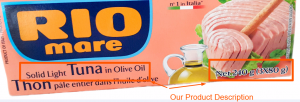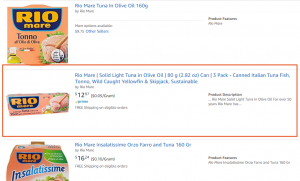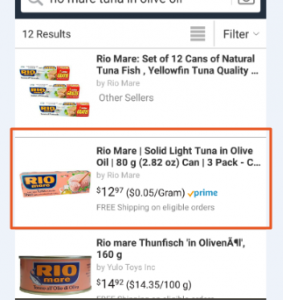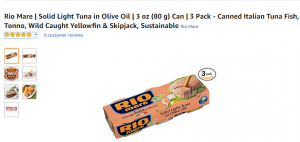Of all the sales copy in your Amazon listing, the title is likely to be the most impactful. In the fleeting moments you have to capture the attention of Amazon shoppers, your title must skillfully corral them into your listing before they wander to greener pastures.
In this blog we’ll outline a step-by-step method for creating highly impactful Titles. Whether you sell in Amazon Seller Central or Vendor Central, writing strong titles can heavily improve sales.
Before we get started, we operate on the assumption that you’ve already conducted thorough keyword research. If you haven’t then there are many tools out there to assist you in your keyword research:
Once you’ve performed adequate Keyword Research and have determined the top 8 – 10 keywords for your product, you can now dive into the process.
For our purposes, we’ll use the following listing which we optimized:
Step 1: State Brand Name
Stating our brand name at the beginning of our title is both a best practice and in accordance with Amazon’s style guide. So we’ll incorporate our brand name into the beginning of our title.
Step 2: Define Product in Clear, Detailed Terms
After stating our brand name we’ll want to define our product in detail. This is where titles often fail. When shoppers scan Amazon listings we have only milliseconds to grab their attention. We need to answer the following question immediately: what is the product we’re selling? We can’t afford to be fancy with our writing style here. Nor can we obsess over keywords alone.
Word choice is crucial. This is a pivotal moment in our sales success. If we don’t state our product in obvious terms we may confuse our shopper. If they’re confused they’ll likely become frustrated or impatient and move onto the next listings. Our opportunity to generate immediate profits and win repeat business will be gone.
We lose.
We want to profit and win.
To do so we recommend the following two-prong approach at the beginning of titles (after stating the brand):
- Clearly define the product
- In so doing cleverly splice into this area as many primary ‘search keywords’ as possible to help search visibility
Balancing both logic and your top search keywords, you’ll want to establish a core phrase that defines your product. We’ve devised the following core phrase:
‘Can of Italian Tuna Fish in Olive Oil’
This is helpful, but we have another trick up our sleeve. In our case, ‘Rio Mare’ is a large, successful brand. As we might expect, such a brand has done a pretty good job on its own of defining its product. We can help ourselves to define our product by merely looking at the label:

Using our two-prong methodology, we’ve devised the following to be the beginning of our Title:
- Rio Mare | Solid Light Tuna in Olive Oil | 80 g (2.82 oz) Can | 3 Pack
Let’s now dissect this.

As you can see, there is a balance between defining our product and incorporating highly searched keywords. There is no exact science to this. If anything, we’ve weighed defining our product as more important in our decision. We can’t under-emphasize the following: if people can’t get a lightning quick idea of what your product is there’s a strong possibility they’ll never click on it to begin with.
Nonetheless, we’re able to slip in some important ‘search keywords’ such as ‘solid’, ‘light’, ‘tuna’, ‘in’, ‘olive’, ‘oil’. All of our previous research indicated these as highly searched terms, though some more than others. Still, we conclude this is the best way to define our product.
You’ll see that the next elements are Size and Quantity. Of course these don’t do much to satisfy our need to incorporate search terms. Nonetheless, shoppers need to understand the size and quantity of what they’re purchasing in order to make decisions.
In our case, we’ve also decided to use both Metric and Imperial measuring systems. Depending on your region you may only need to use one. We’ve created this listing for the USA market. Though most Americans are most familiar with ounces, our product is European and appeals to many Europeans living in the USA. They prefer grams. The packaging of our product also uses grams. So we use both in our title to be safe.
Also, we use the ‘|’ symbol (pipe) to separate the different elements:

We like the pipes as separators because they create abrupt, visual stops in our communication. They help us distinguish between the different elements of our description:
- Brand | Product | Size | Quantity
As mentioned, you can use other punctuation (hyphens, colons, etc.) or none whatsoever. This is merely our preference. It helps our listing scream to shoppers precisely who and what we are. Hopefully it’ll induce clicks.
Not all products will fit neatly into this format. For instance, you may not need to define size and quantity, but may instead need to distinguish a color. In addition, transforming your ‘core phrase’ into an adequate product description may not be as easy for your product as it was for ours. This is especially true if you sell private label products.
It’s very important you take time to understand your product and its key features so you can create a clear and concise description. This is especially so if you are a private label operator.
Step 3: Incorporate Additional ‘Search Keywords’ into Title
So far we’ve used 70 of our allotted 200 characters in our title. We have 130 characters remaining with which to work. We’ll now want to go back to our ‘search keyword’ data and scour our list for highly searched keywords we’ve have not yet used.
Ultimately we decide upon the following for our title:
- Rio Mare | Solid Light Tuna in Olive Oil | 80 g (2.82 oz) Can | 3 Pack – Canned Italian Tuna Fish, Tonno, Wild Caught Yellowfin & Skipjack, Sustainable
This title consumes 151 characters in total. We’re left with 49 additional characters at our disposal. Expert opinions vary widely whether to use all our title’s ‘real estate.’ Amazon’s style guide admonishes us against ‘keyword stuffing’ in the title. However, some experts believe in using every character anyway.
We’ve taken a cautious middling approach. We’d like to think that we haven’t ‘gone overboard’. We’ve limited the back half of our title to only our most important ‘search keywords’. By refraining from distastefully cramming our title with keywords, we hope to neither offend our customers’ sensibilities nor violate Amazon’s style recommendations.
We welcome you to test bolder or more conservative approaches for your product. This is all depends on your personal risk aversion.
Protip: Many experts agree it’s risky to change your title too often. This can hurt your list’s rankings. Unlike other elements of your listing, you should view your title as more permanent. Therefore you should carefully think through your title and stick with it once formulated. If you must change your title, do so infrequently.
Let’s see how our title appears on a desktop screen:

Compared to the neighboring listings, our title is far more thorough. We’ve attempted to balance conveying necessary product information with communicating highly searched keywords.
Now let’s also look at our listing on Amazon’s mobile app:

Optimizing your listing for mobile screens is critical. As you can see, Amazon’s mobile app truncates our title. This magnifies the importance of the beginning of the title. Approximately the first 75 characters of our title show here.
Fortunately, we’ve managed to answer the question of ‘what is our product’ in this space. Shoppers can now make a quick, informed decision about who and what we are. This will increase the likelihood that they click on our ad as opposed to our competitors’ ads.
If amazon optimization techniques aren’t for you we can help! Get in touch for a FREE consultation so we can help you maximize your Amazon sales.


